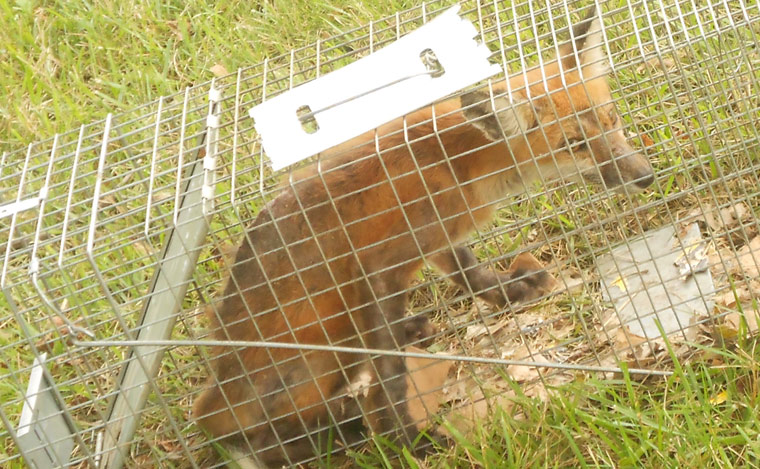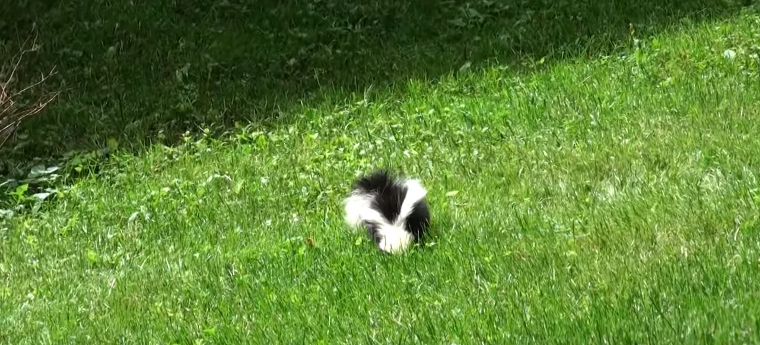-
info@aaanimalcontrol.com
Call us for help in your town
Humane Wildlife Education
Are wild animals active during the daytime rabid?
Need wildlife removal in your hometown? We service over 500 USA locations! Click here to hire us in your town and check prices - updated for year 2020.
The rabies virus is a very misunderstood one, with a whole bunch of myths and urban legends surrounding it. One of those myths, is that nocturnal creatures spotted during the day are almost-always infected with the rabies virus — they are rabid.

It's a myth. There are actually a hundred and one reasons why a wild animal might be out during the day, although the possibility of the rabies virus should never be underestimated.
The animal might have found a decent source of food. Any animal, nocturnal or otherwise, will be tempted enough to wake up when there is the promise of a really good meal. If one rat signals to another rat that there is a dead carcass nearby with plenty of meat still left on the bones, it won't be long before there’s a small party going on, and it won't matter what time of day or night it is. These rodents are scavengers — they'll take food however and wherever they can get it. Sometimes that food is really scarce, and they can't run the risk of wasting a perfectly good opportunity. They don't know when the next opportunity to feed will come.
The animal might be under attack from predators, moving babies from one spot to another. Mothers often do this, especially if they think a male predator is close. Female raccoons, squirrels, opossums, skunks and more will tend to move their babies when wildlife eviction fluid has been quirted around, mostly because the fluid is made up of the urine and other gland secretions from predatory male animals, such as foxes. If the mother picks up on the scent of a male predator, she’s not going to know that it comes in a spray bottle that you can fling around. She thinks a real-life male fox is coming to eat her youngsters. She won't run the risk of that happening, and she will move her babies to a new nest. This can be any time during the day or night — whenever the need arises.
The animal might be diurnal, such as rats. Although believed to be nocturnal, rats actually come out quite a bit during the day. You just don't really see them. They have sleep / wake habits that are very similar to human ones. They’ll do a full night's sleep - 6 to 8 hours, but they’ll wake up a few times during the night. They’ll say hello to loved ones, eat a bit, groom each other, that sort of thing. If ready females are close, they'll mate. They’ll go ‘shopping,' stocking up their food stashes with new delights they’ve found.
The animal might have been disturbed, by a human or another animal. If you were to go up in your attic during the day, for example, and sirupy a colony of bats, there's a good chance they’re going to fly around, outside also, to try and get away from you. Their first line of defense is to run fly away, so they will always try to do this over direct conflict, but that's not to say you are safe. Bats can carry the rabies virus, and they can and will bite you when they feel attacked or cornered. Sometimes these bites can be so tiny, made by the smallest teeth, that you may not even realize you have been bitten at all. This is when the rabies virus becomes particularly dangerous, because you won’t be aware that there is any injury at all, let alone one that can transmit a deadly disease.
A wild animal that is active during the day might not be rabid, but that doesn’t mean it won’t be. There are plenty of reasons why a nocturnal animal might be out during the day, mating, eating, drinking, socializing and more being the biggest reasons. One very big reason, however, could be that the animal IS rabid — it IS infected with the rabies virus. If that's the case, just the one bite or scratch is required for you to become infected, and the same applies to your pets too.
If you see a wild animal out during the day, it’s probably best to keep your distance.
Do skunks come out during the day?
Need skunk removal in your hometown? We service over 500 USA locations! Click here to hire us in your town and check prices- updated for year 2020.
Skunks are sometimes seen out and about during the day, but this doesn't mean that there is something wrong with the animal. Despite the species being known for its nocturnal activities, it is becoming more and more likely that you'll see these, as well as a host of other mostly nocturnal wild critters, during the daylight hours.

Moving about during the day to find food is tough for these creatures. Their black and white nature makes it quite hard for them to hide during the day, especially in the animal's natural habitat. They are very adaptable animals, with the ability to live in a wide and diverse range of habitats. They just need three things close by — something to offer shelter, such as a den, underground burrow, or basement, as well as food and a fresh source of water. As long as the creature has all of those things, it can happily survive.
Moving about during the night to find food makes life much easier. People aren't about so much, and dogs and cats are generally inside, asleep, or pawing at the windows, unable to get into the backdoor and sort that pesky skunk out once and for all. There are other predators that come out at night, of course, but the shy animal has a better chance of moving around in the undergrowth, virtually undetected, with the cover of darkness.
What persuades a skunk to come out during the day?
When the weather is cold, the skunk probably won't come out during the day at all. It's too cold for the animal, and although it doesn't hibernate like bears and other creatures do for the winter, it does fall into long periods of deep slumber. There isn't a lot of food to be found during this time anyway. Flowers don't bloom. Fruits and vegetables don't generally grow. There are very few insects to be found. People don't leave food out for pets quite so much, and bird feeders are rarely refilled. There's no point when there aren't that many birds flying around.
During the spring and summer, on the other hand, the skunk will have a much easier time finding food during the day, just as much as during the night. It will make the most of that, stocking up on food, so to speak, before the winter comes again and food becomes notoriously hard to come by. If there is a lot of food nearby, or the skunk has a family of young to feed, it will be easily persuaded to come out.
Of course, one final reason that could see a skunk (or other wild critter) coming out during the day, especially when it is cold, is when disease has taken hold. This is a naturally occurring situation, as sad as it is, and generally sees the inevitable (and unstoppable) outcome of death before long.
For more information, you may want to click on one of these guides that I wrote:
How To Guide: Who should I hire? - What questions to ask, to look for, who NOT to hire.
How To Guide: do it yourself! - Advice on saving money by doing wildlife removal yourself.
Guide: How much does wildlife removal cost? - Analysis of wildlife control prices.
animals in the attic
noises in the attic


















